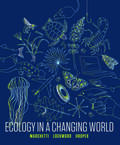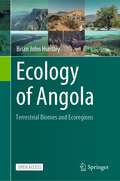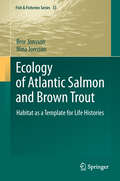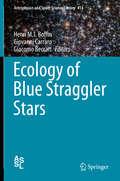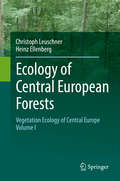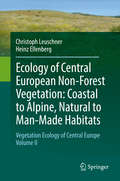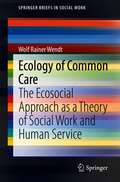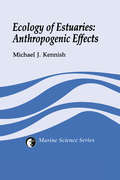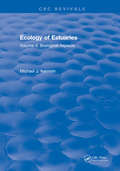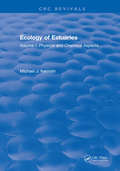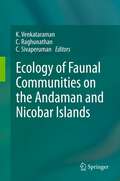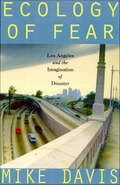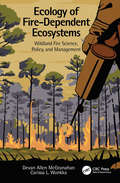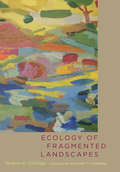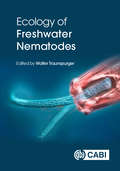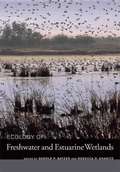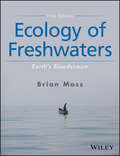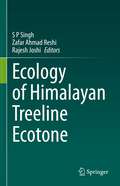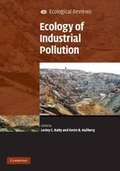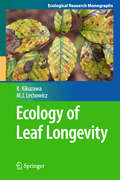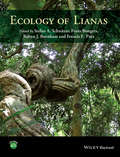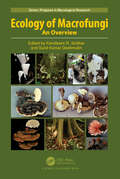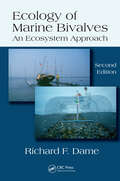- Table View
- List View
Ecology in a Changing World (First Edition)
by Julie Lockwood Michael Marchetti Martha HoopesA modern approach to teaching students how to think like ecologists. Ecology for a Changing World teaches students to think like ecologists, developing their quantitative skills and illuminating connections between research data and real-world phenomena. By examining ecology through the lens of the Anthropocene, this innovative book presents its subject in a manner that is both contemporary and relevant. An integrated media package enriches students’ learning through simulations, activities involving research-based case studies, and easy-to-assign, quantitative, skills-based assessments. This purchase offers access to the digital ebook only.
Ecology of Angola: Terrestrial Biomes and Ecoregions
by Brian John HuntleyThis open access book richly illustrates the first, and comprehensive, account of the country’s biomes and ecoregions, the driving forces that account for their diversity and vulnerability, and the ecological principles that provide an understanding of the patterns and processes that have shaped landscapes, ecoregions, and ecosystems. Angola encompasses the greatest diversity of terrestrial biomes and is the second richest in terms of ecoregions, of any African country. Yet its biodiversity and the structure and functioning of its ecosystems are largely undocumented. The author draws on personal field observations from over 50 years of involvement in ecological and conservation studies in Angola and across Southern Africa. The vast recent literature published by researchers in neighboring, better resourced countries provides depth to the accounts of ecological principles and processes relevant to Angola and thus contributing to the understanding and sustainable management of its natural resources.
Ecology of Atlantic Salmon and Brown Trout
by Bror Jonsson Nina JonssonDestruction of habitat is the major cause for loss of biodiversity including variation in life history and habitat ecology. Each species and population adapts to its environment, adaptations visible in morphology, ecology, behaviour, physiology and genetics. Here, the authors present the population ecology of Atlantic salmon and brown trout and how it is influenced by the environment in terms of growth, migration, spawning and recruitment. Salmonids appeared as freshwater fish some 50 million years ago. Atlantic salmon and brown trout evolved in the Atlantic basin, Atlantic salmon in North America and Europe, brown trout in Europe, Northern Africa and Western Asia. The species live in small streams as well as large rivers, lakes, estuaries, coastal seas and oceans, with brown trout better adapted to small streams and less well adapted to feeding in the ocean than Atlantic salmon. Smolt and adult sizes and longevity are constrained by habitat conditions of populations spawning in small streams. Feeding, wintering and spawning opportunities influence migratory versus resident lifestyles, while the growth rate influences egg size and number, age at maturity, reproductive success and longevity. Further, early experiences influence later performance. For instance, juvenile behaviour influences adult homing, competition for spawning habitat, partner finding and predator avoidance. The abundance of wild Atlantic salmon populations has declined in recent years; climate change and escaped farmed salmon are major threats. The climate influences through changes in temperature and flow, while escaped farmed salmon do so through ecological competition, interbreeding and the spreading of contagious diseases. The authors pinpoint essential problems and offer suggestions as to how they can be reduced. In this context, population enhancement, habitat restoration and management are also discussed. The text closes with a presentation of what the authors view as major scientific challenges in ecological research on these species.
Ecology of Blue Straggler Stars
by Henri M. J. Boffin Giovanni Carraro Giacomo BeccariThe existence of blue straggler stars, which appear younger, hotter, and more massive than their siblings, is at odds with a simple picture of stellar evolution. Such stars should have exhausted their nuclear fuel and evolved long ago to become cooling white dwarfs. They are found to exist in globular clusters, open clusters, dwarf spheroidal galaxies of the Local Group, OB associations and as field stars. This book summarises the many advances in observational and theoretical work dedicated to blue straggler stars. Carefully edited extended contributions by well-known experts in the field cover all the relevant aspects of blue straggler stars research: Observations of blue straggler stars in their various environments; Binary stars and formation channels; Dynamics of globular clusters; Interpretation of observational data and comparison with models. The book also offers an introductory chapter on stellar evolution written by the editors of the book.
Ecology of Central European Forests: Vegetation Ecology of Central Europe, Volume I
by Christoph Leuschner Heinz EllenbergThis handbook in two volumes synthesises our knowledge about the ecology of Central Europe’s plant cover with its 7000-yr history of human impact, covering Germany, Poland, the Netherlands, Belgium, Luxembourg, Switzerland, Austria, Czech Republic and Slovakia. Based on a thorough literature review with 5500 cited references and nearly 1000 figures and tables, the two books review in 26 chapters all major natural and man-made vegetation types with their climatic and edaphic influences, the structure and dynamics of their communities, the ecophysiology of important plant species, and key aspects of ecosystem functioning. Volume I deals with the forests and scrub vegetation and analyses the ecology of Central Europe’s tree flora, whilst Volume II is dedicated to the non-forest vegetation covering mires, grasslands, heaths, alpine habitats and urban vegetation. The consequences of over-use, pollution and recent climate change over the last century are explored and conservation issues addressed.
Ecology of Central European Non-Forest Vegetation: Volume Ii
by Christoph Leuschner Heinz EllenbergThis handbook in two volumes synthesises our knowledge about the ecology of Central Europe's plant cover with its 7000-yr history of human impact, covering Germany, Poland, the Netherlands, Belgium, Luxembourg, Switzerland, Austria, Czech Republic and Slovakia. Based on a thorough literature review with 5500 cited references and nearly 1000 figures and tables, the two books review in 26 chapters all major natural and man-made vegetation types with their climatic and edaphic influences, the structure and dynamics of their communities, the ecophysiology of important plant species, and key aspects of ecosystem functioning. Volume I deals with forests and scrub vegetation and analyses the ecology of Central Europe's tree flora, whilst Volume II is dedicated to the non-forest vegetation covering mires, grasslands, heaths, alpine habitats and urban vegetation. The consequences of over-use, pollution and recent climate change over the last century are explored and conservation issues addressed.
Ecology of Common Care: The Ecosocial Approach as a Theory of Social Work and Human Service (SpringerBriefs in Social Work)
by Wolf Rainer WendtThis book offers an ecological foundation for social work and for care provision in general. It presents the ecosocial approach according to its origins, distinguishing it from other theoretical social work approaches and applying it to various areas of care for welfare. The ecological anchoring of social welfare and common care is an emerging topic in political, organisational, and person-related development of human services and social work. In an era of crisis, this anchoring is an essential contribution to the study of sustainable social provision. The book embeds the dispositions about it in the ecology of the protection and securing of common life. Ecology of Common Care: The Ecosocial Approach as a Theory of Social Work and Human Service is an essential text that should engage the academic community of educators and researchers in social work and other human services professions, as well as students in bachelor's and master's programmes in these professions.
Ecology of Cyanobacteria II
by Brian A. WhittonCyanobacteria have existed for 3.5 billion years, yet they are still the most important photosynthetic organisms on the planet for cycling carbon and nitrogen. The ecosystems where they have key roles range from the warmer oceans to many Antarctic sites. They also include dense nuisance growths in nutrient-rich lakes and nitrogen-fixers which aid the fertility of rice-fields and many soils, especially the biological soil crusts of arid regions. Molecular biology has in recent years provided major advances in our understanding of cyanobacterial ecology. Perhaps for more than any other group of organisms, it is possible to see how the ecology, physiology, biochemistry, ultrastructure and molecular biology interact. This all helps to deal with practical problems such as the control of nuisance blooms and the use of cyanobacterial inocula to manage semi-desert soils. Large-scale culture of several organisms, especially "Spirulina" (Arthrospira), for health food and specialist products is increasingly being expanded for a much wider range of uses. In view of their probable contribution to past oil deposits, much attention is currently focused on their potential as a source of biofuel. Please visit http://extras.springer.com/ to view Extra Materials belonging to this volume. This book complements the highly successful Ecology of Cyanobacteria and integrates the discoveries of the past twelve years with the older literature.
Ecology of Estuaries: Anthropogenic Effects (Crc Marine Science Ser. #1)
by Michael J. KennishEcology of Estuaries represents the most definitive and comprehensive source of reference information available on the human impact on estuarine ecosystems. The volume discusses both acute and insidious pollution problems plaguing these coastal ecotones. It also provides a detailed examination of the deleterious and pervasive effects of human activities on biotic communities and sensitive habitat areas in estuaries. Specific areas covered include organic loading, oil pollution, polynuclear aromatic hydrocarbons, chlorinated hydrocarbons, heavy metals, dredging and dredged-spoil disposal, radionuclides, as well as other contaminants and processes. The diverse components of these anthropogenic influences are assembled in an organized framework and presented in a clear and concise style that facilitates their understanding.
Ecology of Estuaries: Volume 1: Physical and Chemical Aspects
by Michael J. KennishThe objective of this book is to review the physical and chemical characteristics of estuaries. The volume has been designed principally as a reference for scientists, but administers, managers, decision makers, and other professionals involved in some way with estuarine research can find value in the text.
Ecology of Estuaries: Volume 2: Biological Aspects (Crc Marine Science Ser. #1)
by Michael J. KennishThe principle objective of this book is to review the biological characteristics of estuaries. The volume has been as a text for undergraduates and graduate students as well as reference for scientists conducting research on estuarine systems. And the rapid development of estuarine ecology as a field of scientific inquiry reflects a growing awareness of the immense societal importance of a coastal ecosystem. While the volume of literature on estuaries amassed, scientists deemed it necessary to synthesize the field periodically. Consiquently, several books have been produced in recent years which examine variuous aspects of the disicpline.
Ecology of Faunal Communities on the Andaman and Nicobar Islands
by C. Sivaperuman K. Venkataraman C. RaghunathanThe Andaman and Nicobar Islands, India, consist of 572 islands with a land area of 8,249 km2. Their topography is hilly and undulating, with elevations up to 732 m on the Andaman and up to 568 m on the Nicobar Islands. They are known for their rich biodiversity and a very high degree of endemicity in all taxa, especially in plants, reptiles, fishes and corals. Their habitats include bays, mangroves, moist deciduous forests and evergreen forests. Comprising 20 chapters each written by an expert or professional in his/her particular field this book offers new insights into the fascinating faunal communities of these islands and provides the fundamentals for their conservation and environmental management.
Ecology of Fear: Los Angeles and the Imagination of Disaster
by Mike DavisRich with detail, bold and original, Mike Davis's Ecology of Fear is a gripping reconnaissance into the urban future, an essential portrait of America at the millennium. Los Angeles has become a magnet for the American apocalyptic imagination. Riot, fire, flood, earthquake...only locusts are missing from the almost biblical list of disasters that have struck the city in the 1990s.From Ventura to Laguna, more than one million Southern Californians have been directly touched by disaster-related death, injury, or damage to their homes and businesses. Middle-class apprehensions about angry underclasses are exceeded only by anxieties about blind thrust faults underlying downtown L.A. or about the firestorms that periodically incinerate Malibu. And the force of real catastrophe has been redoubled by the obsessive fictional destruction of Los Angeles--by aliens, comets, and twisters--in scores of novels and films. The former "Land of Sunshine" is now seen by much of the world, including many of L.A.'s increasingly nervous residents, as a veritable Book of the Apocalypse theme park. In this extraordinary book, Mike Davis, the author of City of Quartz and our most fascinating interpreter of the American metropolis, unravels the secret political history of disaster, real and imaginary, in Southern California. As he surveys the earthquakes of Santa Monica, the burning of Koreatown, the invasion of "man-eating" mountain lions, the movie Volcano, and even Los Angeles's underrated tornado problem, he exposes the deep complicity between social injustice and perceptions of natural disorder. Arguing that paranoia about nature obscures the fact that Los Angeles has deliberately put itself in harm's way, Davis reveals how market-driven urbanization has for generations transgressed against environmental common sense. And he shows that the floods, fires, and earthquakes reaped by the city were tragedies as avoidable--and unnatural--as the beating of Rodney King and the ensuing explosion in the streets.
Ecology of Fire-Dependent Ecosystems: Wildland Fire Science, Policy, and Management
by Devan Allen McGranahan Carissa L. WonkkaEcology of Fire-Dependent Ecosystems is brimming with intriguing ecological stories of how life has evolved with and diversified within the varied fire regimes that are experienced on earth. Moreover, the book places itself as a communication between students, fire scientists, and fire fighters, and each of these groups will find some familiar ground, and some challenging aspects in this text: something which ultimately will help to bring us closer together and enrich our different approaches to understanding and managing our changing planet. -- Sally Archibald, Professor, University of the Witwatersrand, Johannesburg, South Africa Most textbooks are as dry as kindling and about as much fun to sink your teeth into. This is not that kind of textbook. Devan Allen McGranahan and Carissa L. Wonkka have taken a complex topic and somehow managed to synthesize it into a comprehensive, yet digestible form. This is a book you can read cover to cover – I know, I did it. As a result, I took an enlightening journey through the history and fundamentals of fire and its role in the natural and human world, ending with a thoughtful review of the evolving relationship between humans and wildland fire. -- Chris Helzer, Nebraska Director of Science, The Nature Conservancy, and author of The Prairie Ecologist blog Ecology of Fire-Dependent Ecosystems: Wildland Fire Science, Policy, and Management is intended for use in upper-level courses in fire ecology and wildland fire management and as a reference for researchers, managers, and other professionals involved with wildland fire science, practice, and policy. The book helps guide students and scientists to design and conduct robust wildland fire research projects and critically interpret and apply fire science in any management, education, or policy situation. It emphasizes variability in wildland fire as an ecological regime and provides tools for students, researchers, and managers to assess and connect fire environment and fire behaviour to fire effects. Fire has not only shaped social and ecological communities but pushed ecosystems beyond previous boundaries, yet understanding the nature and effects of fire as an ecological disturbance has been slow, hampered by the complexity of the dynamic interactions between vegetation and climate and the fear of the destruction fire can bring. This book will help those who study, manage, and use wildland fire to develop new answers and novel solutions, based on an understanding of how fire functions in natural and social environments. It reviews literature, synthesizes concepts, and identifies research gaps and policy needs. The text also explores the interaction of fire and human culture, demonstrating how fire policy can be made adaptable to cultural and socio-ecological objectives.
Ecology of Fragmented Landscapes
by Sharon K. CollingeAsk airline passengers what they see as they gaze out the window, and they will describe a fragmented landscape: a patchwork of desert, woodlands, farmlands, and developed neighborhoods. Once-contiguous forests are now subdivided; tallgrass prairies that extended for thousands of miles are now crisscrossed by highways and byways. Whether the result of naturally occurring environmental changes or the product of seemingly unchecked human development, fractured lands significantly impact the planet’s biological diversity. In Ecology of Fragmented Landscapes, Sharon K. Collinge defines fragmentation, explains its various causes, and suggests ways that we can put our lands back together.Researchers have been studying the ecological effects of dismantling nature for decades. In this book, Collinge evaluates this body of research, expertly synthesizing all that is known about the ecology of fragmented landscapes. Expanding on the traditional coverage of this topic, Collinge also discusses disease ecology, restoration, conservation, and planning.Not since Richard T. T. Forman's classic Land Mosaics has there been a more comprehensive examination of landscape fragmentation. Ecology of Fragmented Landscapes is critical reading for ecologists, conservation biologists, and students alike.
Ecology of Freshwater Nematodes
by Nabil Majdi Janina Schenk Mike Hodda Christoph Ptatscheck Birgit Gansfort Tom Moens Sebastian Höss Hendrik FueserNematodes are incontestably the most numerous and the most diverse metazoans in freshwater habitats, and these properties bestow exceptional significance to their role in the environment. An array of functional roles has been attributed to them: they are grazers on bacteria and primary producers, regulators of decomposition of plant material, predators, prey for other animals, and closely associated symbionts of bacteria and other organisms. Freshwater nematodes are central in the context of environmental monitoring, pollution assessments, global warming and food webs, and this is increasingly being recognized. Moreover, the short generation time (a few days to months) of many species makes nematodes ideal for laboratory studies. This book: Provides a follow-up to Freshwater Nematodes: Ecology and Taxonomy (2006). Offers guidelines for studying the ecology of free-living nematodes, including detailed protocols and case studies. Promotes free-living nematodes as model organisms for studies in a broad range of research fields. Despite the recognized importance of nematodes across ecosystems, many species of free-living nematodes have yet to be discovered, and essential knowledge gaps remain. Ecology of Freshwater Nematodes provides an overview of research efforts in this field, and is an important resource for researchers in the field of nematology and ecology.
Ecology of Freshwater and Estuarine Wetlands
by Darold Batzer Rebecca SharitzDesigned as a textbook, this volume is an important, up-to-date, authoritative, and accessible survey in ecology of freshwater and estuarine wetlands. Prominent wetland scholars address the physical environment, geomorphology, biogeochemistry, soils, and hydrology of both freshwater and estuarine wetlands. Careful syntheses review how hydrology and chemistry constrain wetlands plants and animals. In addition, contributors document the strategies employed by plants, animals, and bacteria to cope with stress. Focusing on the ecology of key organisms, each chapter is relevant to wetland regulation and assessment, wetland restoration, how flood pulses control the ecology of most wetland complexes, and how human regulation of flood pulses threatens wetland biotic integrity. Ideal for the classroom, this book is a fundamental resource for anyone interested in the current state of our wetlands.
Ecology of Freshwaters: Earth's Bloodstream
by Brian R. MossThe new edition of this established textbook, now with full colour illustration, has been extensively revised and continues to provide a comprehensive, stimulating, readable and authoritative coverage of freshwater habitats, their communities and their functioning, the world over. The work will be of great value to undergraduate and graduate students, fellow researchers and water managers, and the plain language and lack of jargon should make it accessible to anyone interested in the functioning and current state of lakes and rivers. Having taught and researched over fifty years and six continents, Professor Brian Moss makes here extensive use of his personal experience as well as the huge literature now available on freshwaters. This is the fifth edition of his textbook, which, since the first edition in 1980, has steadily evolved to reflect a rapidly changing science and environment. It places increasing emphasis on the role of people in damaging and managing freshwaters as we move into the Anthropocene epoch and face unprecedented levels of climate and other changes, whilst rejoicing in the fascination of what are left of near pristine freshwater ecosystems. Professor Moss retired from the University of Liverpool following a career in Africa, the USA and the UK. He was awarded medals by the International Society for Limnology, of which he was President from 2007 to 2013, and The Institute of Ecology and Environmental Management. He was given The Ecology Institute's Excellence in Ecology Prize in 2009 and the book written for that prize, Liberation Ecology, was awarded the British Ecological Society's best ecology book prize in 2013.
Ecology of Himalayan Treeline Ecotone
by Rajesh Joshi S P Singh Zafar Ahmad ReshiThis book brings together comprehensive multi-disciplinary knowledge on diverse aspects of the Himalayan treeline ecotone which is considered one of the most sensitive ecosystems to climate change. The contents of this book are based on the results of extensive research and provide a holistic understanding of the treeline ecotone in Himalaya. The book will serve as an important reference manual and a textbook on treeline ecology. The book is unique in the sense that it provides an engaging account of almost all the aspects of the treeline ecotone, such as taxonomic, functional and phylogenetic species diversity, temperature lapse rates, tree phenology, water relations, and stress physiology, tree ring width chronology, and climate relationships and the role of treeline ecotone in human sustenance in the Indian Himalayan region The treelines in the Himalaya, being the highest in the Northern Hemisphere (up to 4900 m), are among the least investigated systems and hence this book is timely and fills all-important knowledge gaps vis-à-vis treeline shifts, physiognomic, structural, and functional changes in mountain landscapes and ecosystems, particularly under the changing climate This book, for the first time, summarizes evidence-based knowledge about various aspects of treeline ecotone in Himalaya that was largely generated through a well-coordinated a team science approach. The book will be of interest to ecologists, climatologists, dendrochronologists, foresters, plant physiologists and resource managers and policy planners for a better understanding of the organization and dynamics of this fragile ecosystem in relation to climate change and other anthropogenic stresses that are rampant in the Himalaya. The book lays a solid foundation for further investigation of the ecology and dynamics of the treeline ecotone in the Himalayas and provides a rationale for pursuing a team science approach for macroecological investigations.
Ecology of Industrial Pollution
by Lesley C. Batty Kevin B. HallbergWritten for researchers and practitioners in environmental pollution, management and ecology, this interdisciplinary account explores the ecological issues associated with industrial pollution to provide a complete picture of this important environmental problem from cause to effect to solution. Bringing together diverse viewpoints from academia and environmental agencies and regulators, the contributors cover such topics as biological resources of mining areas, biomonitoring of freshwater and marine ecosystems and risk assessment of contaminated land in order to explore important questions such as: What are the effects of pollutants on functional ecology and ecosystems? Do current monitoring techniques accurately signal the extent of industrial pollution? Does existing policy provide a coherent and practicable approach? Case studies from throughout the world illustrate major themes and provide valuable insights into the positive and negative effects of industrial pollution, the provision of appropriate monitoring schemes and the design of remediation and restoration strategies.
Ecology of Invertebrate Diseases
by David I. Shapiro-Ilan Ann E. HajekA rapidly growing interdisciplinary field, disease ecology merges key ideas from ecology, medicine, genetics, immunology, and epidemiology to study how hosts and pathogens interact in populations, communities, and entire ecosystems. Bringing together contributions from leading international experts on the ecology of diseases among invertebrate species, this book provides a comprehensive assessment of the current state of the field. Beginning with an introductory overview of general principles and methodologies, the book continues with in-depth discussions of a range of critical issues concerning invertebrate disease epidemiology, molecular biology, vectors, and pathogens. Topics covered in detail include: Methods for studying the ecology of invertebrate diseases and pathogens Invertebrate pathogen ecology and the ecology of pathogen groups Applied ecology of invertebrate pathogens Leveraging the ecology of invertebrate pathogens in microbial control Prevention and management of infectious diseases of aquatic invertebrates Ecology of Invertebrate Diseases is a necessary and long overdue addition to the world literature on this vitally important subject. This volume belongs on the reference shelves of all those involved in the environmental sciences, genetics, microbiology, marine biology, immunology, epidemiology, fisheries and wildlife science, and related disciplines.
Ecology of Leaf Longevity
by Kihachiro Kikuzawa Martin J. LechowiczLeaf longevity is a fundamental process underlying patterns of variation in foliar phenology and determining the distinction between deciduous and evergreen plant species. Variation in leaf longevity is associated with a wide array of differences in the physiology, anatomy, morphology and ecology of plants. This book brings together for the first time information scattered widely in the botanical literature to provide a clear and comprehensive introduction to the nature and significance of variation in leaf longevity. It traces the development of ideas about leaf longevity from the earliest descriptive studies to contemporary theory of leaf longevity as a key element in the function of leaves as photosynthetic organs. An understanding of variation in leaf longevity reveals much about the nature of adaptation at the whole plant level and provides fundamental insights into the basis of variation in plant productivity at the ecosystem level. The analysis of leaf longevity also provides a process-based perspective on phenological shifts associated with the changing climate. Readers will find this an informative synthesis summarizing and illustrating different views in a readily accessible narrative that draws attention to a central but too often unappreciated aspect of plant biology. The nature and causes of seasonal patterns in the birth and death of individual plant leaves are essential to the understanding of the health of plant communities, biomes, and consequently our planet.
Ecology of Lianas
by Stefan Schnitzer Francis E. Putz Robyn J. Burnham Frans BongersLianas are woody vines that were the focus of intense study by early ecologists, such as Darwin, who devoted an entire book to the natural history of climbing plants. Over the past quarter century, there has been a resurgence in the study of lianas, and liana are again recognized as important components of many forests, particularly in the tropics. The increasing amount of research on lianas has resulted in a fundamentally deeper understanding of liana ecology, evolution, and life-history, as well as the myriad roles lianas play in forest dynamics and functioning. This book provides insight into the ecology and evolution of lianas, their anatomy, physiology, and natural history, their global abundance and distribution, and their wide-ranging effects on the myriad organisms that inhabit tropical and temperate forests.
Ecology of Macrofungi: An Overview (Progress in Mycological Research)
by Sunil Kumar Deshmukh Kandikere R. SridharMacrofungi have significant importance in human health, particularly in nutrition, medicine, pharmaceuticals, agriculture and industries. They occupy a variety of ecosystems such as terrestrial (agricultural lands, forests and deserts), freshwater (bogs and marshes) and maritime (mangroves and coastal sand dunes) habitats. Their ecosystem services like nutrition (humans and animals), medicinal pursuits (antibiotics and pharmaceuticals) and bioremediation (degradation of xenobiotics and insect control) potential are dependent on their diversity and ecological conditions. Macrofungal ecology serves as the basis for nutraceutical values, agricultural benefits, plant productivity, environmental protection and industrially valued biocomposites. This book focuses on various aspects of macrofungal distribution in diverse habitats, participation in organic matter decomposition, ectomycorrhizal associations and participation in biogeochemical cycles. This book reviews the current developments in macrofungal ecology in different habitats and their benefits. Due to the topics dealt with on macrofungal diversity, distribution, dynamics, lifestyles, ecosystem or substrate preferences and ecosystem services, this book is valuable to mycologists, botanists, zoologists, ecologists, foresters, geneticists, agronomists and field biologists.
Ecology of Marine Bivalves: An Ecosystem Approach, Second Edition (Crc Marine Science Ser.)
by Richard F. DameExploring the potential use of bivalves as indicators and monitors of ecosystem health, this book describes live and computer simulated experiments, mesocosm studies, and field manipulation experiments. This second edition discusses major new developments, including phase shifts in many coastal and estuarine ecosystems dominated by suspension-feeding bivalves, the invasion or introduction of alien bivalve species, the rapid growth of environmental restoration focused on bivalves, and the examination of geological history with regard to global climate change and its impact on bivalve-dominated systems.
